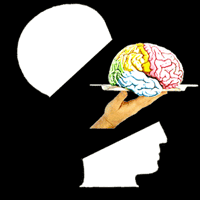Home E-Mail a Friend About this Site Search Suggested Reading


|
Home E-Mail a Friend About this Site Search Suggested Reading
|
|
Dennis B. Kottler, MD Westlake Village, CA Appointments: 818-991-8376 Email: doc@psychiatrix.com Click images for more information: Please also see: Anxiety-Relieving Techniques (Interactive Version)
To help relieve anxiety try these techniques: Slow Abdominal Breathing Exercise In this exercise we use the count of "FIVE." On "ONE," inhale, feeling your stomach go out. On "TWO," "THREE," and "FOUR," exhale, feeling your stomach go in. On "FIVE," pause for a second and let the diaphragm rest. A person might do the exercise over a several minute period repeating this several times a day. The important thing to remember is that you must always take more time to exhale then to inhale. You also want to make sure you have very little chest movement and that the breaths come from the diaphragm. Short, shallow breaths increase anxiety, while long, slow breaths decrease anxiety. This is the most natural way to breathe; this is the way babies breathe. This exercise can be done anywhere, under any circumstances. No one will know what you are doing or even that you are doing anything. It will not look any different than the normal breathing pattern if done correctly. The breathing is to be done slowly and naturally, without any gasping or gulping inhalations or forced exhalations. When facing a difficult situation common wisdom says, "take a deep breath." They just forgot to tell us when to let it out.
Monitor for Breath-Holding Many anxious people hold their breath. They are not even aware they do this. This is an unconscious reaction to anxiety. Learn to become conscious of this tendency to hold the breath. Each time this is discovered, release the breath slowly and practice the slow, abdominal breathing, at least for a breath or two.
Progressive Muscle Relaxation A useful exercise in reducing anxiety is progressive muscle relaxation. Starting with the muscles of the scalp, progressing to the face, neck, shoulders, arms, chest, abdomen, legs, and feet, one first tenses and then relaxes all these muscle groups. In the tensing phase, hold the tension for several seconds, then gradually release the tension. As the tension is released there is an increasing feeling of a "draining" of the anxiety out of the body. This exercise can be repeated several times a day, each time working from head to toe. If time is a problem, the exercise can be abbreviated and still have benefit. As one gets proficient at this form of anxiety reduction, the relaxed state can often be achieved in seconds.
Scanning Scanning is related to the above "progressive relaxation" exercises. In scanning the person does an inventory of muscles from head to toe, searching out areas of tension and attacking them with progressive relaxation. It is incredible how much tension builds up in various muscle groups in the course of the day. Common areas of high muscle tension include the jaw, the neck, the shoulders, the fists, and the back.
Imagine This Another useful device to counteract anxiety is to visualize some peaceful place. This can be a beach scene, the mountains, or anything that brings comfort and serenity to the mind. Remember, there is no set formula here, since a scene that is tranquil to one person may arouse anxiety in another...perhaps due to bad associations to that setting.
To help abort panic attacks try these techniques: Distraction - The mind can't be in two places at once. If the panic attack is imminent or hasn't reached its full potential yet, it is often possible to distract the mind by focussing on some interesting object in the environment and directing thoughts to that object. Other distractions can involve talking to a companion, listening to music, taking a brief walk, or anything else that gets the mind off the anxiety. Identify and redirect away from panic cues - Many people have particular settings which tend to induce panic. A common stimulus is the huge warehouse store. When in such a setting, the panic prone person can focus on the eye-level goods, and avoid contemplating the vast expanse of the store, the harsh lighting, etc., which seem to be cues for some people to start on a course of escalating panic. Other common panic triggers are closed-in spaces, heights, crowds, and wide open spaces. Again, it helps to focus on particular objects (or people) in the environment to redirect away from the panic stimulus. Self-reassurance - Once it is established that the problem is panic attacks, it helps to "talk" to oneself, to reassure oneself that this is not life-threatening and that it will pass. The body cannot maintain itself in panic mode all that long...it is very energy consuming. Special objects of security - Some people find it very helpful to have with them a comforting object around which they have conditioned themselves to feel relaxed. This can be something as simple as a marble or as complicated as a bottle of Xanax (an anti-anxiety medication)....which often doesn't have to be used but just within reach. Other - There are a myriad of other "techniques" that can help abort panic attacks, many of which a creative person can discover him (her)self. Article by Author: "Why We Have Generalized Anxiety and Panic Disorder and What We Can Do About It" Article by Author: "Why We Have Obsessive Compulsive Disorder and What We Can Do About It" Additional Suggested Readings Please also see: Anxiety-Relieving Techniques (Interactive Version) Appointments: 818-991-8376 Email: doc@psychiatrix.com |
|
|